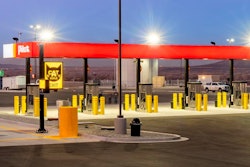Fuel is one of the largest expenditures on a fleet’s operating budget, and prices at the pump recently reached record highs, putting a dent in trucking companies’ bottom lines. But driver behavior can help reduce that expense.
Once upon a time, fleets only covered fuel savings during training, but telematics has provided a much more modern, scientific approach that gives drivers real-time guidance in the cab.
Telematics hardware provider Geotab, which offers sources of detailed and historical information on fuel trends as well as monthly reports on fuel usage through its MyGeotab platform to help fleets increase fuel efficiency and manage fuel costs, identified the top reasons for unnecessary fuel consumption: unnecessary idling; aggressive driving like excessive speeding, rapid acceleration, harsh braking and cornering, tailgating, excessive lane changes and running stop signs; lack of route optimization; inaccurate tire pressure; vehicle and cargo weight; oxygen sensor malfunction and lack of maintenance.
“Even though the fuel prices are rocky, using fleet management technology is a good way to maximize vehicle MPG performance and reduce fuel costs,” said Ethan Weir, senior devops engineer for Geotab.
He said using a fleet management system is an effective way to tackle, track and monitor idling, and telematics help fleet managers set idle limits and generate idling cost reports. Coaching drivers and promoting safer on-road behaviors is simplified with telematics technology, too, he said, recommending fleets set up a driver scorecard to effectively evaluate drivers based on how efficiently they drive and share results and set up rewards for top performers to help motivate drivers to aim for those top spots.
Through CalAmp’s telematics, fleets can schedule reports to be sent to different managers for review so they can pinpoint specific issues like fuel efficiency.
Bill Westerman, CalAmp’s vice president of product management, said reducing excessive idling, which burns just under a gallon of fuel per hour; stopping aggressive driver behavior such as harsh braking and acceleration, which contribute to excess fuel usage; and understanding vehicle performance like how tire pressure can impact fuel economy, are areas where telematics can help fleets reduce fuel-related costs.










